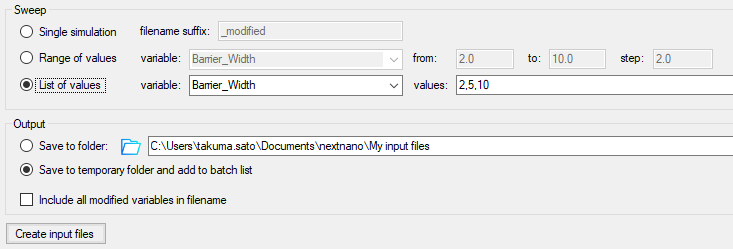Transmission (CBR)¶
Header¶
- Input Files:
transmission-barrier_1D_nnp.in
transmission-step_1D_nnp.in
transmission-quantum-well_1D_nnp.in
transmission-double-barrier_Birner_JCEL_2009_1D_nnp.in
- Scope of the tutorial:
Transmission coefficient
- Relevant output files:
bias_00000\bandedge_Gamma.dat
bias_00000\CBR\transmission_cbr_Gamma.dat
bias_00000\Quantum\probabilities_shift_cbr_Gamma.dat
Introduction¶
In this tutorial, we calculate the transmission coefficient \(T(E)\) as a function of energy \(E\). We consider the following pedagogical examples we learn in undergraduate quantum mechanics courses.
Single potential barrier
Step potential
Quantum well
Double potential barrier [BirnerCBR2009]
To calculate transmission spectra with nextnano++, we use Contact Block Reduction (CBR) method. This tutorial is an analog of here.
Single potential barrier¶
We first consider transmission through a finite quantum barrier. \(10~\mathrm{nm}\) barrier is located in a \(50~\mathrm{nm}\) sample. After running the input file transmission-barrier_1D_nnp.in, we obtain the following band edge profile. The barrier height is set to \(E_{barrier} = 0.3~\mathrm{eV}\).
Figure 2.4.14.1 The conduction band edge profile (bandedge_Gamma.dat).¶
With nextnano++, one can calculate the transmission spectrum using the CBR method ([BirnerCBR2009]). The sample input file is generalized so that you can change the barrier width and alloy content (which determines the barrier height).
Here we look into the barrier width dependence.
In nextnanomat, go to ‘Template’ tab and select the input file.
Then, you can select how to sweep the value at the bottom (List of values) and variable Barrier_Width.
The list of values shows up automatically, as it is specified in the input file with the tag ListOfValues.
Clicking the button Create input files generates multiple input files by sweeping variables.
Please go to ‘Simulation’ tab and run the simulation.

The result is written in transmission_cbr_Gammma.dat. The barrier width \(w\) affects the transmission coefficient as shown in Figure 2.4.14.2.
Figure 2.4.14.2 The transmission coefficient as a function of energy for different barrier width \(w~\mathrm(nm)\). The dashed line marks \(E_{barrier}\).¶
Classical mechanics argues that the transmission is \(0\) below \(E_{barrier}\) and abruptly increases to \(1\) at \(E_{barrier}\). However, quantum mechanics allows electrons with energy below \(E_{barrier}\) to go through the barrier. This effect becomes even larger when the barrier is thin (\(w = 5~\mathrm{nm}\) in this example). Quantum mechanics also predicts a oscillatory behavior above \(E_{barrier}\).
Step potential¶
For a step potential structure (transmission-step_1D_nnp.in) as shown in Figure 2.4.14.3 (a), the transmission of electrons with energy below \(E_{barrier}\) is prohibited because the barrier is infinitely thick.
Figure 2.4.14.3 The conduction band edge profile is shown in (a). The transmission spectrum for a step potential is shown in (b). Transmission is only allowed above the step.¶
Quantum well¶
Similarly, a quantum well structure can be simulated with transmission-quantum-well_1D_nnp.in. The well width is \(w = 10~\mathrm{nm}\) here. Again the transmission of electron within the barriers is impossible because the barrier is infinitely thick. Above 0 eV, the spectrum shows an oscillatory behavior.
Figure 2.4.14.4 The conduction band edge profile is shown in (a). The transmission spectrum for a quantum well is shown in (b). The dashed line marks the top of the barrier.¶
Double potential barrier¶
Finally, we consider a double barrier structure with wall width \(10~\mathrm{nm}\), transmission-double-barrier_Birner_JCEL_2009_1D_nnp.in. The barrier interval is \(10~\mathrm{nm}\).
Figure 2.4.14.5 The conduction band edge profile is shown in (a). The probability distribution \(|\psi(x)|^2\) of the two resonant modes. The transmission coefficient of the double barrier structure is shown in (c). The spectrum has two sharp peaks below the barrier height \(0.1~\mathrm{eV}\), which corresponds to the resonant mode within the barriers.¶
This system has two resonant modes localized between the barriers. The band structure and wave functions are written in bandedge_Gamma.dat and Quantumprobabilities_shift_cbr_Gamma.dat, respectively. In the transmission spectrum, one can clearly see the sharp transmission at the energies of the resonant states in the quantum well. Note that the vertical axis is logarithmic scale.
A resonant tunneling diode (RTD) is an example of a device that exploits this \(\delta\)-function-like behavior of transmission coefficient \(T(E)\).
CBR efficiency assessment¶
Transmission_GaAs_AlAs_Birner_JCEL_2009_1D_Double_Barrier_nnp.in is used for this section. Figure 4 in [BirnerCBR2009] compares the transmission coefficient of a double barrier structure for different number of eigenstates considered in the CBR method. The following figure shows the result reproduced by nextnano++ and demonstrates that the first resonant peak is accurately reproduced using incomplete set of eigenstates. The spectrum is not identical to the previous result because the barrier width here is \(2~\mathrm{nm}\).
Figure 2.4.14.6 Transmission coefficient for three different CBR parameters. The blue curve is the result considering complete set of eigenstates, whereas violet and orange curves take into account only 40 % and 10 % of them, respectively.¶
See also for 3D case for another CBR efficiency assessment.
Last update: nn/nn/nnnn